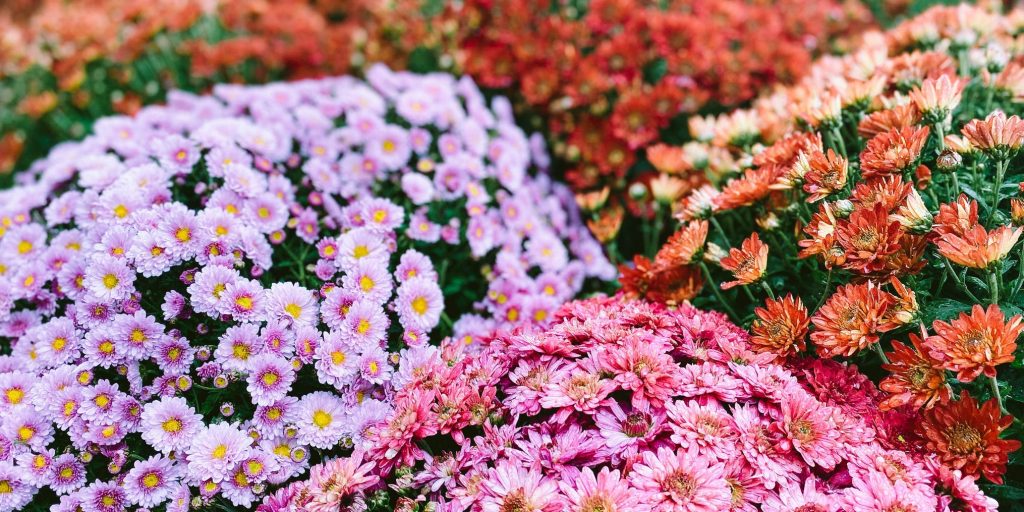
Grace Cary/Getty Images
- Mums are a cheerful flowering plant known for their autumnal appeal.
- While mums can be perennials, those sold in the autumn are meant to be grown as annuals.
- Make sure to give your mums plenty of water and light.
- Visit Insider's Home & Kitchen Reference library for more stories.
Chrysanthemums, known as mums, are a hallmark of fall. They offer color and new life to your garden as the rest of the plants are slowly tapering off.
"Many annuals at this time can look stressed," says Chris Conant, Vice President and Co-owner of Claussen's Nursery in Colchester, Vermont. "With the end of summer and a new season upon us, everyone is ready to welcome the change of seasonal color and texture that chrysanthemum (mums) bring."
Some like to treat their autumn mums as a slightly hardier bouquet or like fall décor, where the pot is put inside and tossed when the blooms fade. There's nothing wrong with this, and if you go this route, you won't have to feed or fertilize your mums. However, planting them outside will ensure a longer, more colorful lifespan. Insects and deer don't love them, meaning they don't require as much pest control. Plus, these beautiful blooms come in a range of colors.
Are mums annuals or perennials?
Annuals are plants that must be replanted every year. Perennials will return each year in the spring. "Most mums are perennials," says Conant. Mums labeled "hardy mums" are generally intended as perennials, but, if you live in a more temperate zone, start looking for mums in the spring. Planting them in the spring, with the rest of a garden, will give them time to develop a strong enough root system to survive the winter.
That said, if you're in a harsher climate, your mums may not last year-round. If you live in a climate with harsh winters, most of the mums sold near you will likely be intended as annual mums. Mums sold in the fall are almost always intended as annuals, as their energy will be put into blooming, rather than into building strong roots.
If you want mums that will last year after year, look for "garden mums" and plant them in the spring. If you're looking for temporary fall decor, opt for "florist mums" or just anything you can start buying the fall. Don't feel bad about tossing them at the end of the season, as they wouldn't have come back next year anyway.
Water
Unless you're growing perennial mums, your plant will have a shallow root system. As such, it needs consistent watering. This should average around an inch a week, applied either daily or every other day. Conant recommends checking your plants for dry soil, even after rainfall, as the more sunlight they receive, the more water they'll need.
Perennial mums have a little more leeway with watering, as soil in the ground generally has better drainage than that in a potted houseplant. A light watering, applied directly to the soil once a day should suffice.
Fertilizer and potting

Linda Raymond/Getty Images
Mums prefer rich soil that's either lightly acidic or neutral. It's important that the soil have adequate drainage. No need to overthink this, as most potting soils are made for plants that shouldn't be overwatered. But, it can be helpful to mix some compost into your soil when you plant the mums, whether that's in the fall or in the spring, and to fertilize monthly with a standard garden fertilizer.
If you're growing perennial mums, get them into the ground in the spring. Fall mums can be left in their planters and left on your doorstep or treated as indoor houseplants.
Temperature
"Chrysanthemums love cool temperatures, especially evening temperatures," says Conant. "With warmer temperatures, you will notice signs of stress on the plant." Signs of stress could include the plant dropping leaves or flowers, or the leaves turning yellow. Shorter sunny days and cooler evenings will give the blossoms more saturated colors, Conant explains.
Light
Mums prefer full sunlight, at least six hours per day, so be sure to place it somewhere it'll be getting the most sunlight it can. If the sunlight is direct, they can manage on even just three hours a day.
Trimming and pruning
When your mums are in bloom, there's typically no need to actively trim or prune them. That said, if you notice a bud fading, feel free to pinch it off to encourage the plant to keep blooming.
If you'd like to try to "winter" your chrysanthemums or try to treat them as perennials, Conant recommends cutting ⅔ of the plant back once it's done flowering. Plant the remaining third into the ground and cover it in the late fall with evergreen boughs or straw. Uncover in early spring or when the ground starts to thaw.
Common problems with chrysanthemums

Photo credit John Dreyer/Getty Images
Mums are hardy but can fall prey to rot or leaf spot fungi like Septoria chrysanthemi. If you notice browning or drooping, hold off on the watering for a while. If the problem does not improve in a week or so, consider garden fungicides.
Whenever possible, water the soil directly and leave the plant dry in order to minimize breeding ground for rot or bacteria.
Propagation
To propagate, Conant recommends cutting the root ball (the mass of roots once you've pulled the plant up) in half, then dividing it further into four separate plants. "Keep in mind weather plays a huge part in growth of Chrysanthemums and propagation may be difficult if the weather fluctuates," he says.
Insider's takeaway
Mums are a fairly easy-going plant that can perk up your garden in the fall. Just make sure to give them plenty of light and water, and well-drained soil. If you're hoping for perennial mums, just make sure to plant them in the spring and to take good care of them throughout their growing season, so they have the fortitude to survive the winter.










